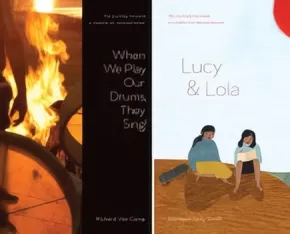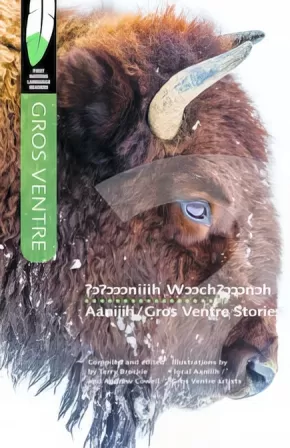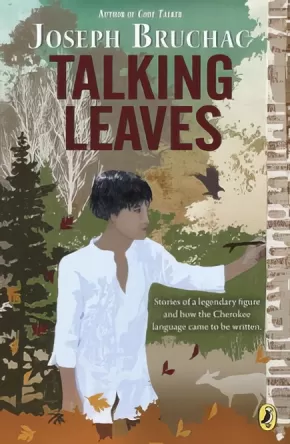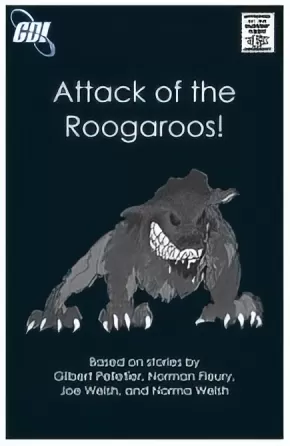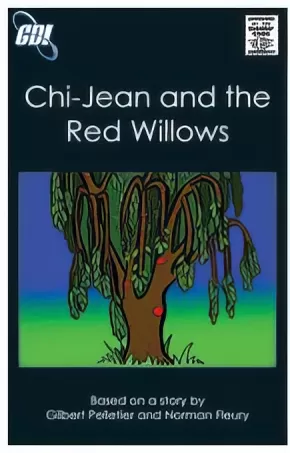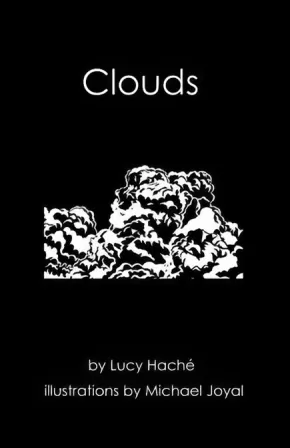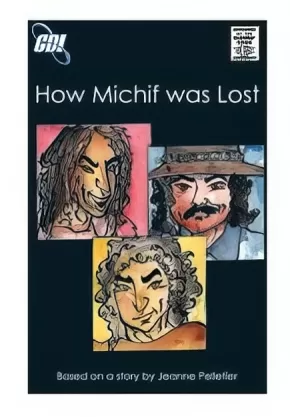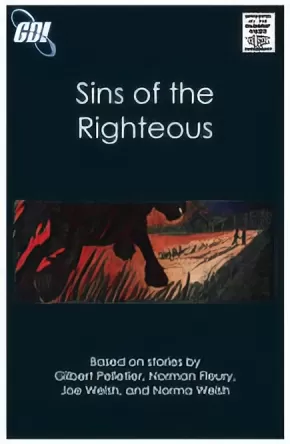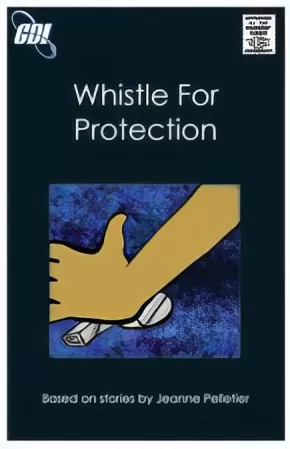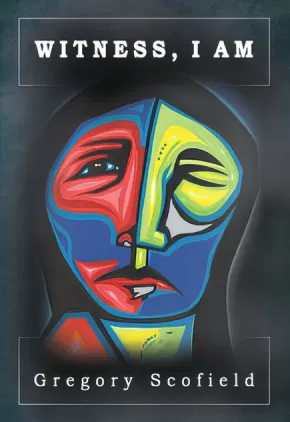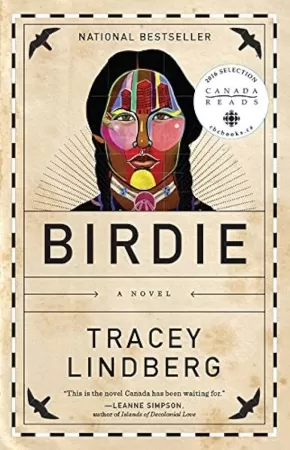
Indigenous Stories
46
-
60
of
79 Results;
Sort By
Go To
of 6
The Journey Forward, A Novella On Reconciliation
$13.99
Artists:
Format:
Paperback
Text Content Territories:
Indigenous Canadian;
ISBN / Barcode: 9780991678266
Synopsis:
Synopsis:
Two award-winning voices.
Two stories on Reconciliation.
Two amazing covers.
One unforgettable book.
The Journey Forward, A Novella On Reconciliation:
When We Play Our Drums, They Sing!
by Richard Van Camp
This the story of 12-year-old Dene Cho, who is angry that his people are losing their language, traditions, and ways of being. Elder Snowbird is there to answer some of Dene Cho’s questions, and to share their history including the impact Residential schools continue to have on their people. It is through this conversation with Snowbird that Dene Cho begins to find himself, and begins to realize that understanding the past can ultimately change the future.
Tessa Macintosh’s wonderful photographs are featured on the cover and interior of this memorable story.
The Journey Forward, A Novella On Reconciliation:
Lucy & Lola
by Monique Gray Smith
Lucy and Lola are 11-year-old twins who are heading to Gabriola Island, BC, to spend the summer with their Kookum (grandmother) while their mother studies for the bar exam. During their time with Kookum, the girls begin to learn about her experiences in being sent — and having to send their mother — to Residential school. Ultimately, they discover what it means to be inter-generational survivors.
Award-winning illustrator Julie Flett created the amazing cover illustration and interior spot art that perfectly suit this engaging novella.
Educator Information
Recommended for Grades 5-8 for the following subject areas: English Language Arts, Social Studies.
Tipiskawi Kisik: Night Sky Star Stories
$15.00
Format:
Paperback
Text Content Territories:
Indigenous Canadian; First Nations; Cree (Nehiyawak);
ISBN / Barcode: 9781927849460
Synopsis:
Synopsis:
Like the night sky above, Tipiskawi Kisik holds a myriad of tales rooted in an Ininew (Cree) perspective. An exploration of stars and constellations—and their associated mythologies—will greet you with age-old knowledge held by Indigenous people prior to European contact. Through Wilfred Buck’s creative, spiritual, and intelligent understanding of the stars, it will be easy to imagine yourself flying inside the Milky Way with Niska (the Goose) or chasing Mista Muskwa (the Great Bear), just like Tepakoop Pinesisuk (the Seven Birds). Above all, these stories can be passed on to the next generation, so they will know of the rich history, science practices, and culture of the Ininew people.
Additional Information
This is a collection of short stories (approximately 25 pages long) with supporting artwork/illustrations. While not aimed at young readers in terms of reading level, this book would support educators in their teaching of Indigenous astronomy to younger audiences, especially since each short story would work well as a read aloud and includes useful illustrations/diagrams of the night sky.
Aaniiih/Gros Ventre Stories
$24.95
Editors:
Format:
Paperback
Text Content Territories:
Indigenous American; Native American; Gros Ventres (Aaniiih);
ISBN / Barcode: 9780889774803
Synopsis:
Synopsis:
The first-ever collection of Anniiih/Gros Ventre narratives to be published in the Aaniiih/Gros Ventre language, this book contains traditional trickster tales and war stories. Some of these stories were collected by Alfred Kroeber in 1901, while others are contemporary, oral stories, told in the past few years.
As with the previous titles in the First Nations Language Readers series, Aaniiih/Gros Ventre Stories comes with a complete glossary and provides some grammar usage. Delightfully illustrated, each story is accompanied by an introduction to guide the reader through the material.
The Aaniiih/Gros Ventre people lived in the Saskatchewan area in the 1700s, before being driven south during the 1800s to the Milk River area in Montana, along the USA/Canada border.
Educator & Series Information
This book is published in the Aaniiih/Gros Ventre language. An English glossary is provided at the back of the book.
The Canadian Indigenous Books for Schools list recommends this resource for Grades 10-12 for these subjects: English Language Arts, Indigenous Language Studies, Language Studies.
Aaniiih/Gros Ventre Stories is part of the First Nations Language Readers series. With a mix of traditional and new stories, each First Nations Language Reader introduces an Indigenous language and demonstrates how each language is used today. The University of Regina Press’s long-term goal is to publish all 60+ Indigenous languages of Canada.
Additional Information
120 pages | 5.50" x 8.50" | Compiled and Edited by Terry Brockie and Andrew Cowell
Impact: Colonialism in Canada
$12.00
Format:
Paperback
Text Content Territories:
Indigenous Canadian;
Grade Levels: 12; University/College;
ISBN / Barcode: 9781927849293
Synopsis:
Synopsis:
A collection of fiction, poetry, essays and creative non-fiction, this anthology features works by over 20 Indigenous Canadian writers. The book focuses on the effects of colonialism in Canada from both historical and contemporary perspectives.
"These stories are rich in geographies Indigenous peoples journey through today; on streets, in cities, and into the future. These stories will make you think, cry, and heal." —Niigaanwewidam James Sinclair, Editor
Reviews
"Impact: Colonialism in Canada presents writings that are often challenging, thought-provoking, and at times, gut-wrenching. The collection is a testament to strength and resiliency and the potential for healing, both within the Indigenous and non-Indigenous communities. But, it is not easy reading; it demands considerable insight, open-mindedness, and an understanding of an historical concept (i.e. colonialism), all of which point to the book’s being read and/or studied by students in the upper grades of high school. It’s certainly a work that would be a fine reference in a high school library collection, and teachers would find it to be an excellent supplemental text for the study of Aboriginal writers, as well as Canadian history, particularly as a reflection of the impact of colonialism upon Canada’s Indigenous peoples. Highly Recommended." - Joanne Peters, CM Magazine
Educator Information
Recommended for ages 17+
Additional Information
198 pages | 5.50" x 8.50"
Talking Leaves
$11.99
Format:
Paperback
Text Content Territories:
Indigenous American; Native American; Cherokee;
ISBN / Barcode: 9780142422984
Synopsis:
Synopsis:
A work of historical fiction about Sequoyah and the creation of the Cherokee alphabet, from the acclaimed author of Code Talker
Thirteen-year-old Uwohali has not seen his father, Sequoyah, for many years. So when Sequoyah returns to the village, Uwohali is eager to reconnect. But Sequoyah’s new obsession with making strange markings causes friends and neighbors in their tribe to wonder whether he is crazy, or worse—practicing witchcraft. What they don’t know, and what Uwohali discovers, is that Sequoyah is a genius and his strange markings are actually an alphabet representing the sounds of the Cherokee language.
The story of one of the most important figures in Native American history is brought to life for middle grade readers. This text includes a note about the historical Sequoyah, the Cherokee syllabary, a glossary of Cherokee words, and suggestions for further reading in the back matter.
Reviews
* “Bruchac has crafted a tale of depth and universal humanity in this fictionalized account of Sequoyah, the creator of the Cherokee syllabary, and his son, Jesse." —School Library Journal, starred review
“Although the particulars of the novel occur two hundred years ago, the universality of fitting into a blended family and looking for love and acceptance from a once-absent father feel strikingly contemporary." —Horn Book
"A vivid retelling of a pivotal time for the Cherokee nation.” —Kirkus Reviews
Additional Information
288 pages | 5.19" x 7.81"
These Are Our Legends
$24.95
Format:
Paperback
Text Content Territories:
Indigenous Canadian; First Nations; Salish; Interior Salish; St'at'imc (Lillooet, Lil'Wat);
Grade Levels: 12; University/College;
ISBN / Barcode: 9780889773967
Synopsis:
Synopsis:
Like all First Nations languages, Lillooet (Lil'wat) is a repository for an abundantly rich oral literature. In These Are Our Legends, the fifth volume of the First Nations Language Readers series, the reader will discover seven traditional Lillooet sptakwlh (variously translated into English as "legends," "myths," or "bed-time stories.")
These texts are presented in a technical transcription that can be used by linguists, and also in a practical orthography that can be used by Lillooet speakers themselves. An English translation is also given. Basic information on the Lillooet language, its grammar, and a glossary are included in the volume.
With thanks to the Mount Currie Cultural Centre and the Tszil Publishing House.
Series Information
These Are Our Legends is part of the First Nations Language Readers series. With a mix of traditional and new stories, each First Nations Language Reader introduces an Indigenous language and demonstrates how each language is used today. The University of Regina Press’s long-term goal is to publish all 60+ Indigenous languages of Canada.
Additional Information
120 pages | 5.50" x 8.50" | Narrated by Lillooet Elders | Transcribed and Translated by Jan van Eijk
Authenticity Note: This book has been labelled as containing Authentic Indigenous Text because of the narration from Lillooet Elders. It is up to readers to determine if this text will work as an authentic resource for their purposes.
Attack of the Roogaroos!
$5.00
Artists:
Format:
Paperback
Text Content Territories:
Indigenous Canadian; Métis;
ISBN / Barcode: 9781926795775
Synopsis:
Synopsis:
This is the fifth book in the Stories of Our People series.
Educator & Series Information
Stories of Our People/Lii zistwayr di la naasyoon di Michif Series is a departure from other books about Aboriginal or traditional stories. It includes five stories. As readers go through the series, they will notice that the narrative and artwork gets progressively darker. The series starts with trickster stories, then moves to a Whiitigo and Paakuk story, then jumps to a story about selling one’s soul and personal redemption, and finally to a Roogaroo story.
This project came to life from the stories of our Elders, and as such, original transcripts of the stories, prose renditions by Janice DePeel, and biographies of the storytellers and project team are available on the Virtual Museum of Métis History and Culture: www.metismuseum.ca/browse/index.php?id=13100
Based on stories by Norman Fleury, Gilbert Pelletier, Jeanne Pelletier, Joe Welsh, and Norma Welsh.
Stories of Our People/Lii zistwayr di la naasyoon di Michif Series:
Book 1: How Michif was Lost
Book 2: Chi-Jean and the Red Willows
Book 3: Whistle for Protection
Book 4: Sins of the Righteous
Book 5: Attack of the Roogaroos!
Chi-Jean and the Red Willows
$5.00
Artists:
Format:
Paperback
Text Content Territories:
Indigenous Canadian; Métis;
ISBN / Barcode: 9781926795744
Synopsis:
Synopsis:
This is the second book in the Stories of Our People series.
Educator & Series Information
Stories of Our People/Lii zistwayr di la naasyoon di Michif Series is a departure from other books about Aboriginal or traditional stories. It includes five stories. As readers go through the series, they will notice that the narrative and artwork gets progressively darker. The series starts with trickster stories, then moves to a Whiitigo and Paakuk story, then jumps to a story about selling one’s soul and personal redemption, and finally to a Roogaroo story.
This project came to life from the stories of our Elders, and as such, original transcripts of the stories, prose renditions by Janice DePeel, and biographies of the storytellers and project team are available on the Virtual Museum of Métis History and Culture: www.metismuseum.ca/browse/index.php?id=13100
Based on stories by Norman Fleury, Gilbert Pelletier, Jeanne Pelletier, Joe Welsh, and Norma Welsh.
Stories of Our People/Lii zistwayr di la naasyoon di Michif Series:
Book 1: How Michif was Lost
Book 2: Chi-Jean and the Red Willows
Book 3: Whistle for Protection
Book 4: Sins of the Righteous
Book 5: Attack of the Roogaroos!
Clouds
$24.95
Artists:
Format:
Paperback
Text Content Territories:
Indigenous Canadian; Métis; First Nations; Kwakwaka'wakw (Kwakiutl);
ISBN / Barcode: 9780991761074
Synopsis:
Synopsis:
In this brave first book, Lucy Haché transports the reader with intimate revelations on self-awareness and identity by exploring both her personal and ancestral relationship to the sea, forest and sky. Through skilled restraint and beautifully astute description, Haché's prose reaches past her own contemplation to connect us all. Masterfully illustrated by artist Michael Joyal, his stunning and meteorologically accurate cloud drawings contribute to the overall sensory and transcendent experience.
Reviews
“Lucy Haché pulls universal truths from her very personal observations that will resonate long after the reader has put aside this jewel of a book. I loved each word, and every one of Michael Joyal’s perfect illustrations.” —Charles de Lint, author of Moonheart and The Onion Girl
Educator & Series Information
This book is part of the Overhead Series.
Additional Information
62 pages | 5.50" x 8.50" | 20 illustrations | Fiction
Gatherings Journal XV: Youth Water Anthology
$22.95
Editors:
Format:
Paperback
Text Content Territories:
Indigenous Canadian;
ISBN / Barcode: 9781926886404
Synopsis:
Synopsis:
Gatherings XV: Youth - Water Anthology features writing submissions from B.C. based Indigenous Youth on the theme of water.
The Gatherings-Water project reflects the cultural rejuvenation of Indigenous Youth in B.C. It is not only a revival of a respected anthology series, but also a new level of engagement between publishing house and community, between established writers and emerging voices, and finally a testament to the connection of Indigenous Youth with the life-sustaining power of water.
Essays, narratives, fictional pieces and poems are grouped thematically under headings:
- Drip, Drip, Drip
- Splashes
- Tears
- Cleansing Rain
- Rivers Flow
- Waves
- Tsunami
The authors are from all over BC from Haida Gwaii to Vancouver Island.
Educator Information
Useful for English Language Arts courses for grades 10-12.
Additional Information
248 pages | 6.00" x 9.00"
How Michif was Lost
$5.00
Artists:
Format:
Paperback
Text Content Territories:
Indigenous Canadian; Métis;
ISBN / Barcode: 9781926795737
Synopsis:
Synopsis:
This is the first book in the Stories of Our People series.
Educator & Series Information
Stories of Our People/Lii zistwayr di la naasyoon di Michif Series is a departure from other books about Aboriginal or traditional stories. It includes five stories. As readers go through the series, they will notice that the narrative and artwork gets progressively darker. The series starts with trickster stories, then moves to a Whiitigo and Paakuk story, then jumps to a story about selling one’s soul and personal redemption, and finally to a Roogaroo story.
This project came to life from the stories of our Elders, and as such, original transcripts of the stories, prose renditions by Janice DePeel, and biographies of the storytellers and project team are available on the Virtual Museum of Métis History and Culture: www.metismuseum.ca/browse/index.php?id=13100
Based on stories by Norman Fleury, Gilbert Pelletier, Jeanne Pelletier, Joe Welsh, and Norma Welsh.
Stories of Our People/Lii zistwayr di la naasyoon di Michif Series:
Book 1: How Michif was Lost
Book 2: Chi-Jean and the Red Willows
Book 3: Whistle for Protection
Book 4: Sins of the Righteous
Book 5: Attack of the Roogaroos!
Sins of the Righteous
$5.00
Artists:
Format:
Paperback
Text Content Territories:
Indigenous Canadian; Métis;
ISBN / Barcode: 9781926795768
Synopsis:
Synopsis:
This is the fourth book in the Stories of Our People series.
Educator & Series Information
Stories of Our People/Lii zistwayr di la naasyoon di Michif Series is a departure from other books about Aboriginal or traditional stories. It includes five stories. As readers go through the series, they will notice that the narrative and artwork gets progressively darker. The series starts with trickster stories, then moves to a Whiitigo and Paakuk story, then jumps to a story about selling one’s soul and personal redemption, and finally to a Roogaroo story.
This project came to life from the stories of our Elders, and as such, original transcripts of the stories, prose renditions by Janice DePeel, and biographies of the storytellers and project team are available on the Virtual Museum of Métis History and Culture: www.metismuseum.ca/browse/index.php?id=13100
Based on stories by Norman Fleury, Gilbert Pelletier, Jeanne Pelletier, Joe Welsh, and Norma Welsh.
Stories of Our People/Lii zistwayr di la naasyoon di Michif Series:
Book 1: How Michif was Lost
Book 2: Chi-Jean and the Red Willows
Book 3: Whistle for Protection
Book 4: Sins of the Righteous
Book 5: Attack of the Roogaroos!
Whistle for Protection
$5.00
Artists:
Format:
Paperback
Text Content Territories:
Indigenous Canadian; Métis;
ISBN / Barcode: 9781926795751
Synopsis:
Synopsis:
This is the third book in the Stories of Our People series.
Educator & Series Information
Stories of Our People/Lii zistwayr di la naasyoon di Michif Series is a departure from other books about Aboriginal or traditional stories. It includes five stories. As readers go through the series, they will notice that the narrative and artwork gets progressively darker. The series starts with trickster stories, then moves to a Whiitigo and Paakuk story, then jumps to a story about selling one’s soul and personal redemption, and finally to a Roogaroo story.
This project came to life from the stories of our Elders, and as such, original transcripts of the stories, prose renditions by Janice DePeel, and biographies of the storytellers and project team are available on the Virtual Museum of Métis History and Culture: www.metismuseum.ca/browse/index.php?id=13100
Based on stories by Norman Fleury, Gilbert Pelletier, Jeanne Pelletier, Joe Welsh, and Norma Welsh.
Stories of Our People/Lii zistwayr di la naasyoon di Michif Series:
Book 1: How Michif was Lost
Book 2: Chi-Jean and the Red Willows
Book 3: Whistle for Protection
Book 4: Sins of the Righteous
Book 5: Attack of the Roogaroos!
Witness, I Am
$18.95
Format:
Paperback
Text Content Territories:
Indigenous Canadian;
ISBN / Barcode: 9780889713239
Synopsis:
Synopsis:
Witness, I Am is divided into three gripping sections of new poetry from one of Canada's most recognized poets. The first part of the book, "Dangerous Sound," contains contemporary themed poems about identity and belonging, undone and rendered into modern sound poetry. "Muskrat Woman," the middle part of the book, is a breathtaking epic poem that considers the issue of missing and murdered indigenous women through the reimagining and retelling of a sacred Cree creation story. The final section of the book, "Ghost Dance," raids the autobiographical so often found in Scofield's poetry, weaving the personal and universal into a tapestry of sharp poetic luminosity. From "Killer," Scofield eerily slices the dreadful in with the exquisite: "I could, this day of proficient blooms, / take your fingers, / tie them down one by one. This one for the runaway, / this one for the joker, / this one for the sass-talker, / this one for the judge, / this one for the jury. / Oh, I could kill you."
Educator Information
Recommended for students in grades 11 and 12, or at a college/university level, for courses in creative writing, English First Peoples, English, poetry, and English language arts.
Caution: explicit coarse and sexual language.
Additional Information
96 pages | 5.50" x 8.00"
Birdie
$22.99
Format:
Paperback
Text Content Territories:
Indigenous Canadian; First Nations; Cree (Nehiyawak);
ISBN / Barcode: 9781443451352
Synopsis:
Synopsis:
Birdie is a darkly comic and moving first novel about the universal experience of recovering from wounds of the past, informed by the lore and knowledge of Cree traditions. Bernice Meetoos, a Cree woman, leaves her home in Northern Alberta following tragedy and travels to Gibsons, BC. She is on something of a vision quest, seeking to understand the messages from The Frugal Gourmet (one of the only television shows available on CBC North) that come to her in her dreams. She is also driven by the leftover teenaged desire to meet Pat Johns, who played Jesse on The Beachcombers, because he is, as she says, a working, healthy Indian man. Bernice heads for Molly’s Reach to find answers but they are not the ones she expected.
With the arrival in Gibsons of her Auntie Val and her cousin Skinny Freda, Bernice finds the strength to face the past and draw the lessons from her dreams that she was never fully taught in life. Part road trip, dream quest and travelogue, the novel touches on the universality of women's experience, regardless of culture or race.
Educator Information
This book is also available in French as Birdie.
Additional Information
288 pages | 5.50" x 8.50"
Sort By
Go To
of 6

